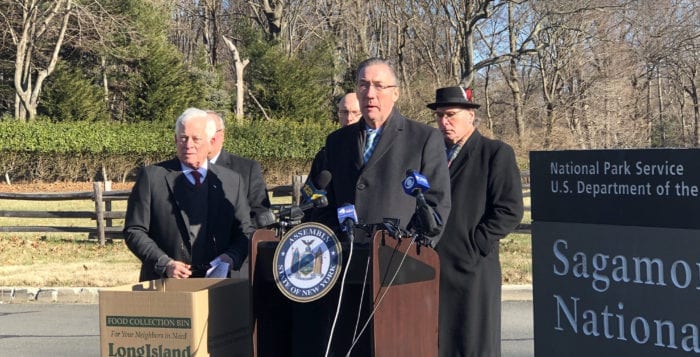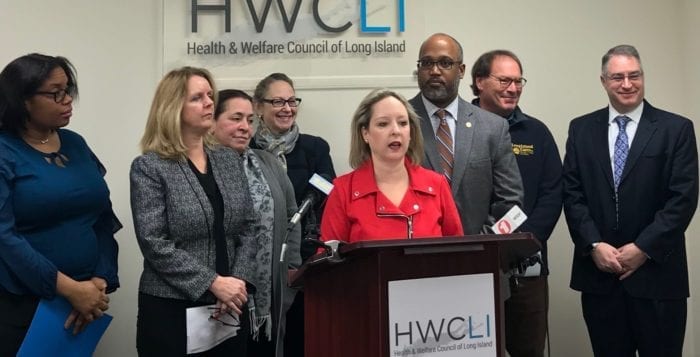A developer’s proposal to reconfigure five properties close to the heart of Huntington village into a singular mixed-use building will go before the Town of Huntington’s Zoning Board tonight for a second time to seek approval.
Developer John Kean of Cold Spring Harbor-based Kean Development Company will present a design to construct a four-story, mixed-use building occupying 1.36 acres including the site of Classic Galleries and the historic Huntington firehouse. It proposes to build 84 apartment units above retail stores and restaurant space along with a below-ground parking garage.
“There’s a lot of misinformation out there about it,” Jim Margolin, an attorney representing the developer said. “We think it’s a good project and good for the village. Hopefully, people will listen.”
“There’s a lot of misinformation out there about it. We think it’s a good project and good for the village. Hopefully, people will listen.”
— Jim Margolin
The project, called Downtown Huntington, was first proposed to the Town of Huntington’s Planning Board in August 2015. Since then, the developer and the property owner Alan Fromkin have revised their preliminary plans four times making changes to the total number of apartments, stories, height of the building and architectural design, according to town officials. The most recent plans were submitted April 10, 2017.
“The bottom line is that this project will provide 127 parking spaces on site and there will be a significant reduction in the size of restaurant and retail use,” Margolin said.
The proposed structure would shrink the street-level retail space from nearly 40,000 down to 11,620 square feet and cut the restaurant floor space in roughly half from 6,400 to 3,853 square feet. Margolin also stressed the current parcels only provide 40 parking slots spread out among the five lots — 235 and 243 Main St., 5-7 Stewart Ave., 11 Stewart Ave. and 12 Gerard St.
Previously, Huntington’s Planning Board first reviewed the proposed development application and gave an advisory recommendation to changes. Among its requests was for the developer to conduct a traffic circulation study and profile renderings, which the town received in August 2018. With these documents in hand, the Planning Board revised its recommendations Wednesday night before the public hearing set for Thursday at 6 p.m.
“People are objecting to the sheer size of it and the extreme number of variances the developer is requesting.”
— Bob Suter
Huntington resident Bob Suter, who helps organize a residential coalition called Save Huntington Village, said he was one of many residents who remains staunchly opposed to the proposed Downtown Huntington development.
“People are objecting to the sheer size of it and the extreme number of variances the developer is requesting,” he said.
Many objectors have spoken out most loudly against variances requested to increase the maximum height of the building from three to four stories and relief for the required number of parking spaces. The parcels are currently zoned for C-6 General Business District, a zoning that Huntington residents have repeatedly called on the town board to review and change. Suter’s group arranged to make preprinted signed protest signs available to residents and business owners for pick-up Jan. 19.
“We handed out close to 200 signs on Saturday in a very short period of time,” he said. “People who were showing up are angry, they are really upset.”
Dozens have taken to social media to vent and have written emails to the town about preserving the former historic Huntington firehouse as a possible landmark in the village.
“While I cannot comment on a specific application before the ZBA, it is the priority of my administration to preserve the historic character and charm of our town while allowing business to flourish.”
— Chad Lupinacci
“While I cannot comment on a specific application before the ZBA, it is the priority of my administration to preserve the historic character and charm of our town while allowing business to flourish,” Huntington Supervisor Chad Lupinacci (R) said in statement. “In 2018, my first year in office, I asked the town’s Planning Department to review possible changes to C-6 zoning and provide recommendations to aid in the preservation of our town’s quaint aesthetic. The Planning Department is still working on those recommendations.”
Margolin said his clients have agreed to restore and preserve the original façade of the building, even though it “wasn’t designated historic by the town board.” Rather, its intended as a sign of goodwill.
Those wishing to voice their concerns, support or opposition regarding Downtown Huntington can participate in the public hearing scheduled for Jan. 24 at 6 p.m. at Huntington Town Hall.
Residents unable to attend Thursday night’s meeting can submit written comments via email to [email protected].















 “This deal puts an end to the uncertainty of this plant over the course of nine years and gives finality to this issue,” Romaine said. “I have always believed that all property assessments should be fairly based on property value.”
“This deal puts an end to the uncertainty of this plant over the course of nine years and gives finality to this issue,” Romaine said. “I have always believed that all property assessments should be fairly based on property value.”


